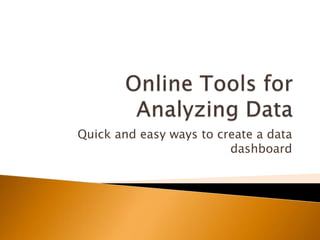Online tools for analyzing data coabe 2014
•Download as PPTX, PDF•
1 like•341 views
Report
Share
Report
Share

Recommended
Recommended
More Related Content
What's hot
What's hot (20)
Data Analytics Life Cycle [EMC² - Data Science and Big data analytics]![Data Analytics Life Cycle [EMC² - Data Science and Big data analytics]](data:image/gif;base64,R0lGODlhAQABAIAAAAAAAP///yH5BAEAAAAALAAAAAABAAEAAAIBRAA7)
![Data Analytics Life Cycle [EMC² - Data Science and Big data analytics]](data:image/gif;base64,R0lGODlhAQABAIAAAAAAAP///yH5BAEAAAAALAAAAAABAAEAAAIBRAA7)
Data Analytics Life Cycle [EMC² - Data Science and Big data analytics]
Session 01 designing and scoping a data science project

Session 01 designing and scoping a data science project
WIT Career Lecture Series - CTeixeira Data Scientist

WIT Career Lecture Series - CTeixeira Data Scientist
Record matching over query results from Web Databases

Record matching over query results from Web Databases
Similar to Online tools for analyzing data coabe 2014
Similar to Online tools for analyzing data coabe 2014 (20)
Getting started in Data Science (April 2017, Los Angeles)

Getting started in Data Science (April 2017, Los Angeles)
OutlierAnalysisIDIO071216.pptx.otliers is the main

OutlierAnalysisIDIO071216.pptx.otliers is the main
DIY ERM (Do-It-Yourself Electronic Resources Management) for the Small Library

DIY ERM (Do-It-Yourself Electronic Resources Management) for the Small Library
Session 01 designing and scoping a data science project

Session 01 designing and scoping a data science project
Online tools for analyzing data coabe 2014
- 1. Quick and easy ways to create a data dashboard
- 2. Exploration of online tools that are cheap (translation:free) and easy to use How to create a dashboard of statistics that speak to stakeholders in your community
- 3. Is it an interesting question? Who is asking the question? Do you have the right data to answer these questions? If you don’t have the data, do you know where to get it? Do you have the right tools to do the analyses? Who is your audience? When do you need to be done?
- 4. Questions to ask: ◦ Does the data have the right information (fields)? ◦ Do you know what each of the values in the relevant fields stand for? ◦ Is the time frame relevant to answering the question? ◦ Is it relevant to the geographical area for which you doing the analysis? ◦ How reliable is the data? ◦ Is it one data set or more than one? ◦ If multiple data sets, can you relate them? ◦ What are the privacy, legal and security concerns?
- 5. For each data element ask the following questions: ◦ Who collects this data? ◦ Why is this data being collected? ◦ Is there a reason for systematic bias in this data? ◦ Does this field contain a lot of missing data? ◦ Does this field contain a large number of outlier values? ◦ Does the data make sense?
- 6. Census (www.census.gov) NCES (nces.ed.gov) NAAL (http://nces.ed.gov/naal/) Other government open data projects ◦ Data.gov (http://www.data.gov/) ◦ NYC open data portal (https://nycopendata.socrata.com/) ◦ NYS open data portal (https://data.ny.gov/) ◦ Data from other government entities (example: School districts)
- 7. What is your MIS system capable of? ◦ Existing reports (with and without dissaggregation) ◦ Downloads of existing reports ◦ Data downloads ◦ Reviewing data screens
- 9. Watch out for ◦ Outliers and invalid values ◦ Number of records that make sense Simple methods for cleaning your data ◦ Sorting in spreadsheets ◦ Frequency counts Validate against other sources
- 10. Google Trends ◦ http://www.google.com/trends/ Google correlate ◦ http://www.google.com/trends/correlate Google Fusion Google Ngram Viewer ◦ https://books.google.com/ngrams Tableau Public ◦ http://www.tableausoftware.com/public/ Microsoft Excel
- 11. Educational Attainment for Kings County
- 12. Venu Thelakkat ◦ venut@lacnyc.org ◦ Adultedgps.blogspot.com
